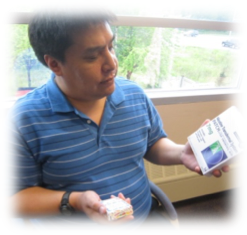Stages of Change-A Different Perspective
| Site: | Joans-place |
| Course: | Tobacco Treatment Specialist Training copy |
| Book: | Stages of Change-A Different Perspective |
| Printed by: | Guest user |
| Date: | Thursday, 18 September 2025, 5:55 AM |
Description
A short review from the ANTHC perspective
1. The Five Stages of Change
 ANTHC provides this perspective on the Five Stages of Change. Relapse is not considered a stage in this context but rather an element to consider at every stage in the process of change.
ANTHC provides this perspective on the Five Stages of Change. Relapse is not considered a stage in this context but rather an element to consider at every stage in the process of change.
2. Pre-Contemplation
 At this stage your client does not want to change or does not know that a change is needed. This can be the “no, not me,” stage!
At this stage your client does not want to change or does not know that a change is needed. This can be the “no, not me,” stage!
Counselor Goal: Encourage the client to think about and discuss his or her problem behaviors.
3. Contemplation
 Your client knows that a change is needed but has not taken any direct or clear action to change. This is the “let me think about this!”
Your client knows that a change is needed but has not taken any direct or clear action to change. This is the “let me think about this!”
Counselor Goal:
Work to define ambivalence and to help the client explore their ambivalence. Help clients explore their feelings.
4. Preparation
 At this point your client has decided that a change is needed. This is where they ask, “What’s next?”
At this point your client has decided that a change is needed. This is where they ask, “What’s next?”
Counselor Goal:
Help the client prepare a plan for change.
5. Action
This is the time where your client will actively work to change their behaviors.

This can be considered the, “OK, let’s do this,” stage.
Counselor Goal: Affirm the client’s successful behavior changes and support the client in addressing barriers to change.
6. Maintenance
Clients in the maintenance stage have achieved their initial goals and are working to maintain the changes made.
Counselor Goal: Reinforce the client’s commitment to change and support the client in (a) managing relapse triggers, (b) creating a coping plan for relapse prevention, and (c) processing any relapses that occur.

7. Relapse
Relapse is when a patient returns to regular tobacco use after quitting. A relapse is different than a lapse (or a slip), which is a return to reduced tobacco use or brief use of tobacco after quitting that falls short of a return to regular tobacco use.
A patient can relapse at any point during their journey in quitting tobacco, not just during the maintenance phase. When a patient does relapse or slip, the most important consideration is their attitude and how the patient plans to respond if relapse or a slip does occur.
Counselor Goal: The counselor should evaluate what stage the client is in at this time and work on strategies appropriate to the stage and rebuilding motivation and self-efficacy as appropriate.